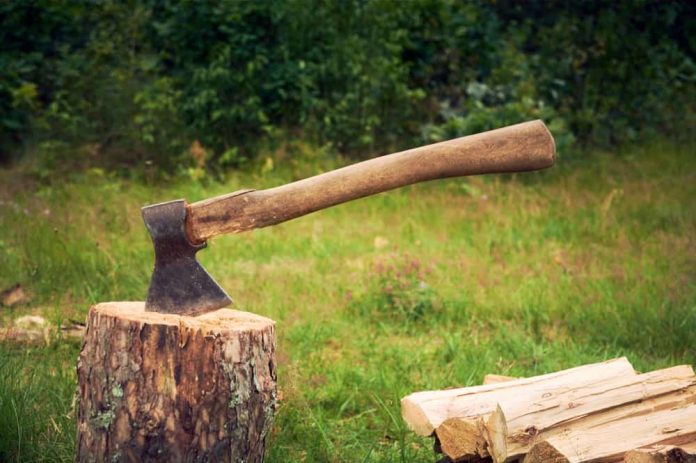As the most important survival skill to learn, we all focus on the ability to start a fire.
Each survival teacher attempts to outdo the last, developing a newer and more creative way to start a fire. Although both of those strategies function and might even be useful at some stage, they will only be useful if we aren’t ready to start it easier.
There’s no need to make a lens out of a chunk of ice that you cut off from a frozen lake, or use a bow drill to glow a lump of coal if you have a decent stormproof lighter to use.
But none of those methods of starting fire would do the least bit of good to either of us, unless we have anything to burn. And for that fire I see very little said about cutting and splitting the wood. The little I do see is associated with a bug-out bag and is mainly concerned with a temporary shelter being built.
Related: Tools You Need For Your Homesteading
In other words, you really wouldn’t want to cut firewood with a pocket chain saw.
Yet if we are going to heat our homes with wood, we will have to face the fact that we will cut and break a lot of logs. Even if we have a chain saw available to us, we’ll eventually run out of gasoline for it. Gasoline doesn’t store as well, so don’t plan to use the chain that was used many years after the electricity is out.
You’ll be lucky if it’s still running after six months.
If you are going to be heating with wood, you’ll need a lot of firewood. People in the northern part of the United States, heated with wood, prefer to burn somewhere between four and six cords of wood each winter, this is strong hardwood too, not pine.
Related: Heat Your House with Wood: Tips & Common Mistakes
That means having the right tools to cut down those trees, then buckle down to the width of your fireplace or wood-burning stove, and then break the logs into usable wood pieces. This is much easier to get the wood to burn, if the heartwood is exposed, rather than just barking, so splitting the wood is often a good idea unless the pieces are so small that they are nothing more than decoration.
Let’s Clarify Something
I want to explain something before looking at any different tool types, the distinction between the axes and mauls. Most people put the two in equation as if they were the same. But they don’t. Although both are useful to having wood for your fire in this process, they can not be used interchangeably.
The main disparity between the two is headwidth. An axis head is narrow, and to make it smaller it may also be hollow ground. She wants to be alert as well. That’s because, as you should have to, the object of the axis is to cut across the wood grain to fall a tree.
Yes, you’ll probably want to sharpen it while you’re using it, since the steel is fairly soft and can rust quickly. Yet when you try to cut wood the narrow head is practically useless.
The maul, on the other hand, has a much thicker head while most mauls look a lot like an axis. Although sharp is good for a maul, it’s not as important as it is for an axe. The key to a maul, then, is leverage. The wide head puts a lot of side-pressure against the wood grain as you push it into the wood, splitting it and causing it to break.
Yet the large head makes cutting a tree down with a maul all but difficult.
Now, on to get the best types of wood cutting tools to pick and break the log. While my goal is to send you categories of devices, I’m listing a few different models that have unique features or have unique methods that make them better than the average.
Related: 18 Vintage Homesteading Tools to Search for at Garage Sales
Felling Axe
Your basic tree-felling tool is the felling axe. Compared to other axes, what makes it special is that it has a long, curved handle which provides a lot of leverage. The leverage explicitly covers the speed at which the axe head travels when it hits the branch, resulting in a deeper cut.
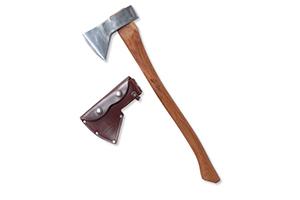

Some people like a double-headed axe as it gives them the choice of getting a bit sharper than the other or going between sharpening for a longer time.
But the bigger head is heavier, making the axe more difficult to wield. As opposed to splitting wood, where weight converts into a greater downwards push from the mail, you have to hold up the weight of that heavier axe head while swinging it horizontally. Which is hard to do unless you’re extremely muscular.
I wouldn’t cut corners, buy a cheap felling axe, because that’s going to mean cheaper steel, which doesn’t stay sharp, just like a cheap knife. I do like the concept of purchasing a blade protected axe because it covers your freshly sharpened blade.
Crosscut Felling Saw
There are times when it is simply not feasible to cut a tree with an axe, particularly with a larger diameter tree. You just do need a saw in such situations. Since we believe you can’t use a chain saw, that means a cross-cut felling saw, which can be a little difficult to locate.
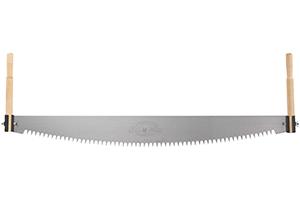

This is the old-fashioned saw used by lumberjacks, before they got their chainsaws. Although we all have a picture of lumberjacks with axes over their heads, a two-man-saw of this kind is seen more often than not.
Then they’d use their axes to cut branches off and prepare the logs to cut to length. For this kind of saw, they would also cut them to length for large enough trees.
Buck Saw
There’s nothing I’ve found that beats an old-fashioned buck saw when it comes to buckling the logs down to a size that’s going to fit into the fireplace.
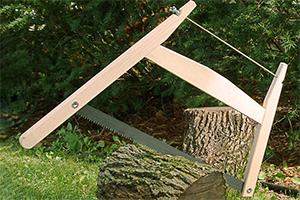

So far as I know, there’s only one place in the world that still sells these, but they’re working as well as ever; maybe better, because they’re using steel of higher quality for the blade.
A form of buck saw would allow bucking branches and trunks much shorter work down to a usable length than a bow saw would. This would also be easier on your hands and able to handle logs of greater diameters.
Splitting Maul
Your basic splitting maul is heavier than an axe, although I’ve seen some that are a bit on the light side. Yet the heavier it is, the more traction you get on the downswing, which results in more force behind the edge of the blade as it reaches the end of the log you’re trying to break.
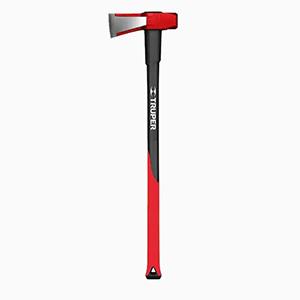

Concentrate on head form when looking for a splitting maul. The broader it allows an angle, the better. But that doesn’t mean you want the whole head to be equal in width. In fact, you’re better off with a head that has narrow protrusions out of the sides than the entire head being wide.
What that would do for you is to will the friction, allowing the head of the maul to fall deeper into the log, resulting in greater splitting power.
A heavier head is also an advantage if you can bear the weight; because it will gain more energy on downswing, resulting in a harder impact. But watch out, if you are not up to the challenge even one extra pound can wear you out quickly.
Chopper 1 Maul
The Chopper 1 Maul is a special splitting maul, which has spring-loaded levers on the head ends. When the blade hits the log these catch on the edge, swinging to the bottom, pushing apart the two sides of the log.
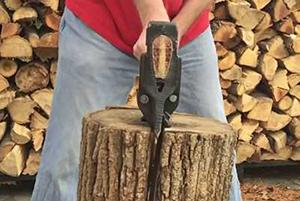

It considerably increases the leverage, allowing for much more lateral splitting motion out of each stroke.
Wielding needs a lot of energy, because you have to push the blade through the log deep enough to engage the levers, but you have to do it anyway to break the log with some maul.
The only potential drawback to this maul is that it might be split by the springs and levers making it less powerful to use. But from what I can see, looking at online reviews, this doesn’t seem to be a concern.
Leveraxe
The Leveraxe is a complete redesign of the splintering maul. Although it’s called an “axe,” I don’t see how it can be used to cut a tree down; every promotional video they’ve got of it shows it’s being used as a splitting maul, and it’s incredibly successful at that. It is also relatively lightweight which makes it much easier to use.
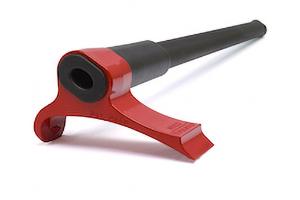

The entire thing about this tool is that it is making full use of leverage.
The head is out of line with the blade, so it immediately twists to the side when the blade hits the log, prying the wood on it. This unique action of chopping makes it possible to use the easiest log splitter, particularly for people who are not all that strong.
Kindling Cracker
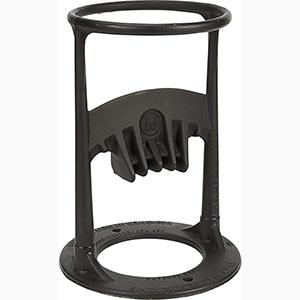

The Kindling Cracker takes logs that split and turns it on its head. It places the blade in a frame, instead of putting the blade on the handle, in which the wood is then placed in. A sledgehammer is used to crack the wood.
That tool provides the advantage for those who don’t split wood too much, that you don’t have to have a clear target for your tool.
When you are prone to hit the wood at the wrong angle with the maul and bounce off to the side, this is the tool for you.
Hydraulic Log Splitter
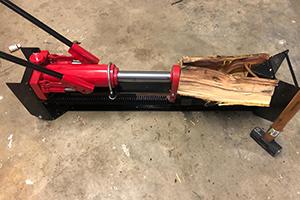

If you buy split firewood, a gas powered hydraulic log splitter has already been used to split it.
Of course, if you don’t have fuel to run your chainsaw, you won’t have fuel either to power your hydraulic splitter. That is, except you have a gas-driven splitter.
There are not too many hydraulic log splitters that are manually operated out there but there are a few.
This is the perfect resource if you are going to have someone who isn’t doing the job all that well. Although sluggish, a manual hydraulic log splitter is simple to use when compared to the other methods we’ve spoken about. It’s really very easy for the kids to use.



